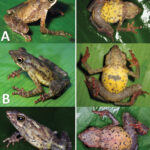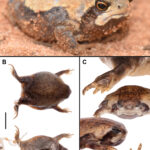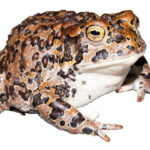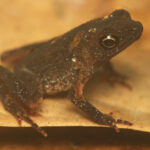The Hidden Jewel of the Andes: Discovering the Atelopus lozanoi Frog#
Amid the dense emerald forests and misty slopes of the Colombian Andes, an elusive and beautifully vibrant amphibian quietly navigates streams, rock crevices, and moss-covered branches. Known scientifically as Atelopus lozanoi, this unique harlequin toad embodies both nature’s artistry and evidence of its fragility. With striking coloration, fascinating behaviors, and a vital ecological role, this small amphibian has captured the attention of conservationists, scientists, and wildlife enthusiasts alike. Yet, despite its visual allure, the story of the Atelopus lozanoi is tinged with urgency—a narrative where delicate balance meets critical conservation concerns.
Taxonomy and Classification#
Belonging to the diverse Bufonidae family, Atelopus lozanoi resides within the genus Atelopus, commonly recognized as harlequin frogs or toads. First described scientifically in 1979 by Osorno-Muñoz, Ardila-Robayo & Ruíz-Carranza, this particular species earned its spot as a distinctive member of this colorful genus. Characterized by their slender forms, vivid coloration, and skin secretions containing diverse chemical compounds, Atelopus species are among the most charismatic amphibians of neotropical regions, serving as essential symbols in conservation advocacy. Closely related to other species such as Atelopus spurrelli and Atelopus laetissimus, the taxonomy of these frogs provides important insights into evolutionary adaptation within unique ecosystems.
Natural Habitat#
Geographic Distribution#
The natural home of Atelopus lozanoi is intricately tied to the cloud forests and montane ecosystems of Colombia’s Andean region, specifically localized within the Cordillera Central. Here, in an altitude ranging approximately from 2,000 to 3,500 meters above sea level, conditions become ideal for the survival of this species. Rich humidity, stable temperatures, and an abundant presence of freshwater streams and seepages constitute its perfect sanctuary.
Habitat Preferences#
Imagine stepping into a world enveloped by cool mist, where moss-draped trees stretch skyward, and crystal-clear streams carve their way through thick forest floors. It is precisely here that Atelopus lozanoi thrives. Typically, individuals are found perched near streams and cascades, resting on damp rocks and fallen logs or nestled amidst the dense tangle of mosses and bromeliads. The frog requires pristine freshwater habitats with low disturbance, as its highly permeable skin necessitates uncontaminated water. It is an amphibian adapted superbly to the delicate balance of humidity, temperature stability, and lush vegetation that Colombia’s central highlands offer.
Physical Characteristics#
This diminutive yet magnificent frog typically measures 2 to 4 centimeters in adult length, showcasing a slender, elongated body shape emblematic of the harlequin genus. Atelopus lozanoi boasts a visually striking pattern of colors—bright yellows, greens, or sometimes deep oranges contrasted sharply by intricate dark markings, each individual uniquely adorned as if hand-painted by nature itself. The brilliant coloration is far from decorative alone; it’s an essential adaptation warning potential predators of the potent toxins secreted through their skin. These alkaloid toxins discourage predation and play critical roles in the species’ survival strategy.
Eyes large and expressive, limbs slender yet powerful for leaping considerable distances, Atelopus lozanoi displays evolutionary refinements ideally suited for its mountainous, moist environment. Their smooth and moist skin provides an effective respiratory surface, absorbing oxygen directly from the humid surroundings—a remarkable evolutionary trait enforcing their dependence on intact ecosystems with stable humidity and temperature.
Behavior and Life Cycle#
Feeding Habits#
Atelopus lozanoi, like others in its genus, relies primarily on small invertebrates such as ants, beetles, mites, and tiny flies. Hunting mostly by sight, it uses its excellent vision and lightning-fast tongue strikes to capture prey. They patiently wait amidst moss-covered surfaces, camouflaged from their own prey’s perception, making the most of the forest floor’s bustling miniaturized biodiversity.
Reproduction and Development#
As rainy seasons approach in the Andes, the quiet evening concerts resonate with soft chirping calls from male Atelopus frogs, each attempting to catch the attention of potential mates. The breeding behavior, significantly dependent on seasonal rainfall, involves males gathering near small streams and cascading waterfalls. Females arrive, responding to male calls and specific visual signals. After pairing, females deposit gelatinous clusters of eggs in secluded and clean stream waters, attaching them to submerged rocks or vegetation. Soon after, tadpole stage larvae hatch, equipped with specialized mouthparts adapted to grazing algae and biofilm.
Emerging as tiny tadpoles, Atelopus larvae rapidly adapt to aquatic life, feeding voraciously until they metamorphize, sprouting limbs, shedding their tails, and transitioning toward terrestrial living. The transformative journey from larvae to land-dwelling adults highlights the adaptability, resilience, and fragility inherent in this extraordinary ecosystem cycle.
Ecological Role#
The presence of Atelopus lozanoi within its habitat signals an ecosystem in balance—one rich in quality and biodiversity. Serving as both predator and prey, these frogs regulate invertebrate populations while simultaneously providing sustenance for diverse predators, including birds and small mammals immune to their toxins. Additionally, their aquatic larvae actively manage algae communities contributing to healthier freshwater systems. Most significantly, Atelopus lozanoi serves as an indicator species—a living barometer of environmental health signaling clear warnings about habitat quality, ecosystem stability, and the impacts of human-induced changes, such as pollution or climate warming.
Threats and Conservation Status#
Challenges Facing Atelopus lozanoi#
Unfortunately, Atelopus lozanoi, like its harlequin toad cousins, faces significant threats, resulting in substantial population declines. The International Union for Conservation of Nature (IUCN) currently classifies Atelopus lozanoi as Critically Endangered, an urgent conservation concern highlighting rapidly decreasing population trends. Their localized distribution, dependence on very specialized habitats, and sensitivity to environmental shifts amplify their vulnerability.
Major Threats#
Habitat destruction and fragmentation stemming from agricultural expansion, logging, and infrastructure development pose substantial threats. Moreover, climate change has introduced harmful variations in rainfall patterns and temperature, altering their delicate reproductive cycles and critical habitats. Perhaps most devastatingly, the fungal pathogen Chytridiomycosis, caused by Batrachochytrium dendrobatidis, has swept through populations, severely disrupting skin respiration and electrolyte balance, decimating amphibians globally including populations in Colombia. Combating this deadly fungus is now among the highest priorities for conservationists striving to save this remarkable species.
Cultural and Scientific Significance#
Atelopus frogs, traditionally respected and admired by indigenous communities throughout the Andes, hold noteworthy positions in local mythology, symbolizing natural balance, purity, and environmental health. Their toxins have fascinated researchers, hinting at potential medicinal properties and botanical insights valuable for modern science. Additionally, researchers frequently examine Atelopus populations for indicators of broader environmental change, making the survival of this species critical to biodiversity studies and ecosystem management practices.
Conclusion: Turning Awareness into Action#
Atelopus lozanoi remains a precious yet fragile jewel nestled in the heart of Colombia’s cloud forests. The narrative of this small harlequin frog extends far beyond biology; it is intrinsically tied to ecological balance, environmental ethics, and a dynamic natural heritage deeply needing collective protection and mindful stewardship. For conservation to triumph, awareness and action must go hand in hand—encouraging active engagement from local communities, conservation organizations, governments, and nature enthusiasts alike.
By understanding and actively supporting ongoing conservation efforts, habitat preservation initiatives, and research programs, we can each contribute meaningfully to the protection of this fascinating species. The future of Atelopus lozanoi depends not only on dedicated scientific inquiry but also on widespread advocacy, education, and responsible action around environmental stewardship. After all, safeguarding this hidden jewel ensures the preservation of a vibrant, thriving, and incredibly valuable slice of Earth’s biological tapestry.








